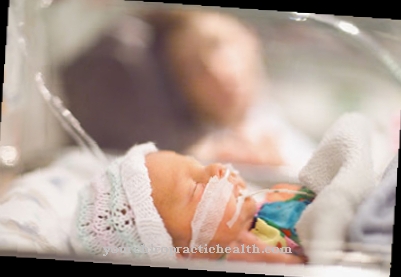The Ceelen-Gellerstedt syndrome is a lung disease that is thought to be classified as an autoimmune disease and causes episodic or chronic bleeding in the lung tissue. Fibrosis often develops from the bleeding. There are currently no causal treatments available for this rare disease.
What is Ceelen-Gellerstedt Syndrome?

© Robert Kneschke - stock.adobe.com
Ceelen-Gellerstedt syndrome is a rare lung disease that appears as bleeding in the alveolar structural elements of the lungs. The disease will too idiopathic pulmonary hemosiderosis called and manifests itself until the third decade of life. Women and men are affected equally often. Since the disease has not been particularly well researched due to its rarity, the causes have not been conclusively clarified, and there are no causal therapies.
The bleeding is usually diffuse. The disease is often confused with vasculitis or collagenosis, since both diseases produce a similar general picture. The Ceelen-Gellerstedt syndrome is usually episodic and relapsing in adults. The complaints do not have to be permanent, but subside and return after a while. Chronic forms were observed in children.
causes
The causes of the Ceelen-Gellerstedt syndrome have not yet been conclusively clarified. Since a familial accumulation could be observed, medicine has so far assumed a genetic disposition which, together with infections or other environmental influences, presumably leads to the outbreak of the disease. Inhalation trauma from insecticides and infection with certain viruses are environmental factors that are often associated with the onset of the disease.
A connection with celiac disease is also possible. Children with the disease in particular often suffer from cow's milk intolerance, which is an interesting observation, especially in combination with celiac disease. The origin of this rare disease is unclear. The bleeding in the lungs is probably caused by autoimmune processes against the body's own tissue.
Symptoms, ailments & signs
During acute episodes, the Ceelen-Gellerstedt syndrome manifests itself in a restrictive ventilation disorder, which usually occurs in combination with global respiratory failure with a paradoxically increased carbon monoxide transfer factor. Symptoms such as a chronically unproductive cough occur. The patients are also often affected by shortness of breath, which mainly occurs during physical exertion. In addition, those affected are easily tired and their skin is noticeably pale. Only in rare cases do patients cough up blood.
Nonetheless, the disease always damages blood vessels in the alveoli of the lungs and thus triggers recurrent hemorrhages into the lung tissue, the extent of which varies from case to case. Since the blood breakdown product hemosiderin is deposited in the lung tissue due to the bleeding, the lungs are irreversibly damaged with each bleeding. More and more connective tissue is being produced in the lungs in response to the damage. Pulmonary fibrosis is the ultimate consequence of these processes.
Diagnosis & course
According to the anamnesis, clinical examinations form the diagnostic basis for the Ceelen-Gellerstedt syndrome. In acute episodes of illness, the doctor hears a rattle during auscultation towards the end of inspiration. With a lung function test, the restrictive ventilation disorder can be observed in acute phases. The thorax is X-rayed to confirm the diagnosis and shows diffuse condensation in the lung parenchyma and the lung hili in acute stages.
The reticular drawing is increased. A blood test often reveals iron deficiency anemia. Scientific authors have so far disagreed about the prognosis. While some speak of a rather favorable prognosis and rarely expect death as a result of the disease, others give an unfavorable prognosis, which assumes a death rate of around ten percent, especially for children and thus the chronic form,
Complications
In most cases, the Ceelen-Gellerstedt syndrome causes breathing disorders. Most patients suffer from acute shortness of breath and a very strong cough. The everyday life of the person affected is severely affected by the breathing disorders. It is no longer possible to practice sports or to perform certain physical activities.
The person concerned is thus restricted in his actions. Breathlessness can lead to panic attacks and further loss of consciousness in many people. Ceelen-Gellerstedt syndrome makes the patient tired very easily and also suffers from headaches and nausea. The tiredness cannot be compensated by sleep.
In severe cases, the bleeding can also damage the lungs. The damage itself is irreversible and cannot be reversed by medical treatment. Targeted treatment is not possible in Ceelen-Gellerstedt syndrome. Most often, drugs are given during the acute phases of the syndrome to relieve symptoms.
In the case of intolerance or allergies, the person affected must pay attention to a certain diet and is restricted in their food intake. The treatment itself does not lead to any complications, but cannot achieve a complete cure.In the worst case scenario, a lung transplant must be performed to keep the patient alive. Different complications can arise because these procedures have not been well researched.
When should you go to the doctor?
A doctor should be consulted promptly in the event of coughing and shortness of breath, which mainly occurs during physical exertion. If these symptoms keep recurring and cannot be traced back to any other cause, there may be a serious illness such as Ceelen-Gellerstedt syndrome. As part of a medical diagnosis, it can be clarified whether it is actually the lung disease - then the necessary therapy can be initiated immediately if necessary.
If there are any further symptoms or signs of pulmonary fibrosis, it is best to contact the emergency medical service. People who suffer from celiac disease are particularly affected. Inhalation trauma caused by insecticides, infection with certain viruses and other environmental influences can also promote the development of the Ceelen-Gellerstedt syndrome.
Whoever these factors apply to should speak to their doctor about the symptoms mentioned. In addition to the general practitioner, a lung specialist or an internist can also be called in. In a medical emergency, the ambulance service should be called or the person affected should be brought to a clinic.
Doctors & therapists in your area
Treatment & Therapy
There are currently no causal treatments for Ceelen-Gellerstedt syndrome. Therapy is therefore symptomatic and, if necessary, supportive, whereby the main focus of supportive measures is to improve the quality of life of those affected and their relatives. Drug treatments are mainly used in acute phases of the disease. Treatment with steroids in particular can make the symptoms subside in acute phases. The same is true for cyclophosphamides.
However, the success of drug therapies observed so far has been limited and has by far not been proven for every case of Ceelen-Gellerstedt syndrome. Severe forms of the disease also require the administration of immunosuppressants such as azathioprine outside of acute phases. If there is a gluten intolerance, a gluten-free diet is also started.
In the case of lactose intolerance, the diet must also be lactose-free. In rare cases, a complete remission of all symptoms could be observed as a consequence of such a diet. If pulmonary fibrosis has already set in, long-term oxygen therapy is often required.
Once there is terminal respiratory failure in the lungs, the final treatment option is a lung transplant. The extent to which this possibility is crowned with success can hardly be assessed due to the minimal research situation. However, since the disease will attack a transplanted lung again, the chance of a transplant is to be assessed as low due to the unlikely long-term success.
Outlook & forecast
The Ceelen-Gellerstedt syndrome cannot be treated causally, so that patients are always dependent on symptomatic treatment. This can usually limit and reduce the symptoms, although in many cases lifelong therapy is necessary.
The Ceelen-Gellerstedt syndrome can often be overcome by an adapted diet, if there is an intolerance to gluten. The same usually applies to lactose intolerance, whereby the diet is also adjusted. In addition to these options, however, most patients are also dependent on therapy with oxygen.
If the symptoms do not go away as a result, Ceelen-Gellerstedt syndrome can only be treated with a lung transplant. Without treatment, life expectancy is significantly reduced and the person concerned continues to die. The symptoms can also reappear after a lung transplant.
However, the likelihood of finding a donor organ is very low. The prognosis for Ceelen-Gellerstedt syndrome is therefore relatively poor, and it also depends on the success of the drug treatment and the exact severity of the syndrome. In general, the treatment is aimed at improving the quality of life, since a complete cure is not possible anyway.
prevention
The causes of the Ceelen-Gellerstedt syndrome are still unclear. Therefore, the disease can hardly be prevented so far. If inhalation trauma or viral infections are actually the triggering factors, vaccinations and the careful handling of insecticides and other poisonous substances can be understood as preventive measures in the broadest sense.
You can do that yourself
Ceelen-Gellerstedt syndrome is a very rare lung disease, the causes of which have not yet been conclusively clarified. The bleeding in the lungs is probably triggered by autoimmune processes that are directed against the body's own tissue. Since the causes of the disease are not known, the person affected cannot take any measures to combat it causally. Many of the symptoms cannot be influenced or only insignificantly influenced by self-help measures.
However, a connection between the disease and certain food intolerances, especially celiac disease, and lactose intolerance is suspected. Those affected who suffer from such disorders can alleviate them through a suitable diet and thus very likely also have a positive effect on the course of the Ceelen-Gellerstedt syndrome.
In the case of gluten intolerance, the adhesive protein gluten must be consistently avoided. Gluten is found in particularly high concentrations in many types of grain, in particular wheat, durum wheat semolina, barley, spelled, oats, rye, green spelled but also in ancient grain, kamut or emmer. Corn, rice, buckwheat and millet, on the other hand, are among the types of grain that do not contain gluten. Amaranth is also free from this substance. Since more and more people prefer a gluten-free diet, even without medical necessity, there is now a wide range of pasta, bread and baked goods in food retailers and health food stores that are also suitable for people with celiac disease.
People suffering from lactose intolerance should familiarize themselves with vegan alternatives to dairy products. Here, too, the range is now very broad and of high quality. Lactose-free dairy products are also available.


.jpg)





















.jpg)



